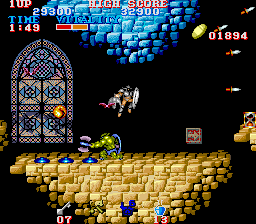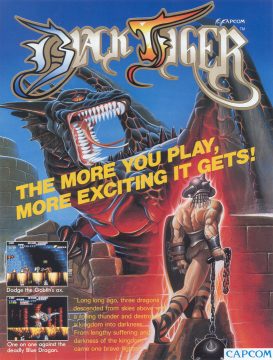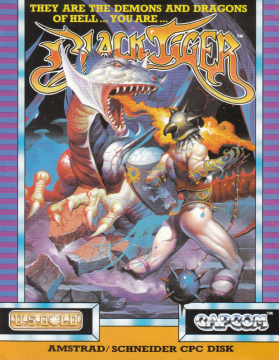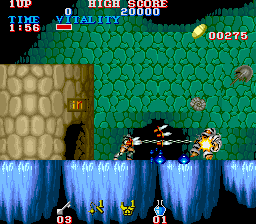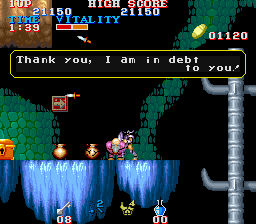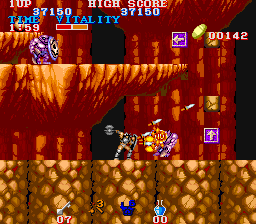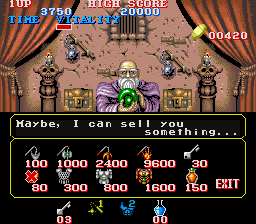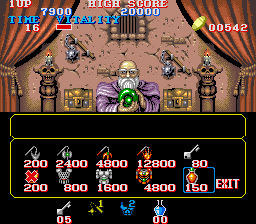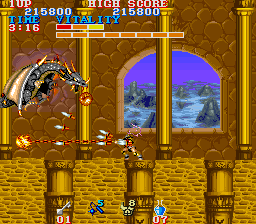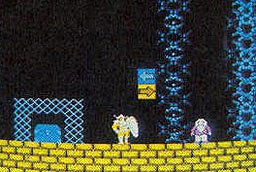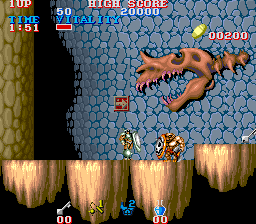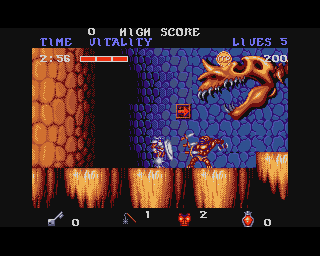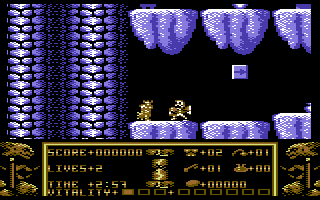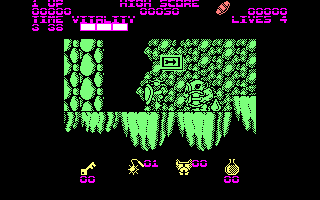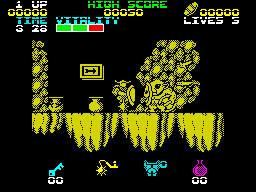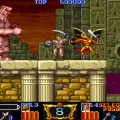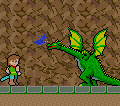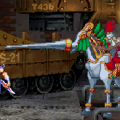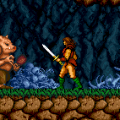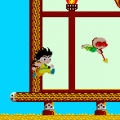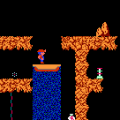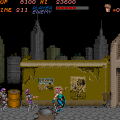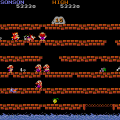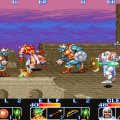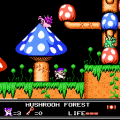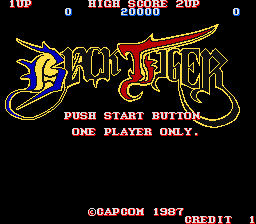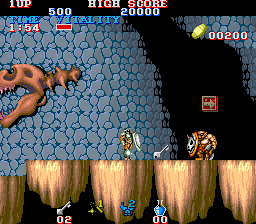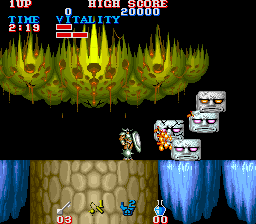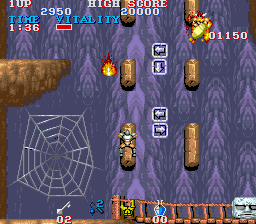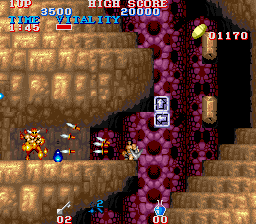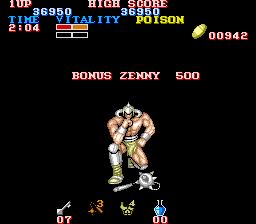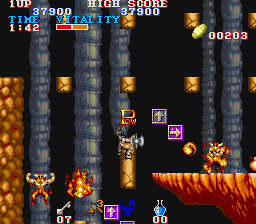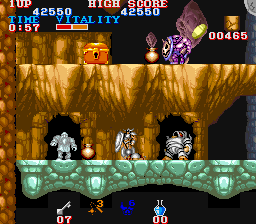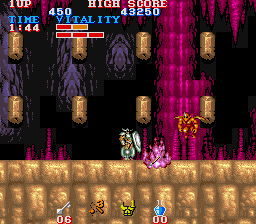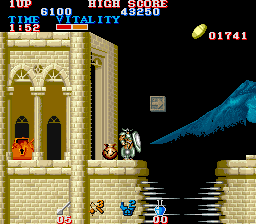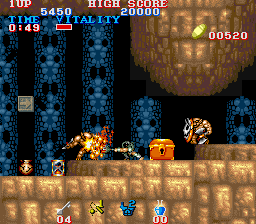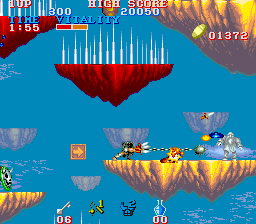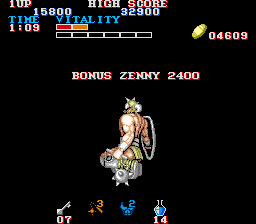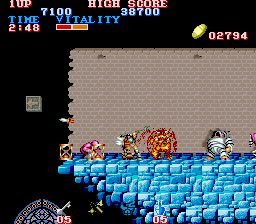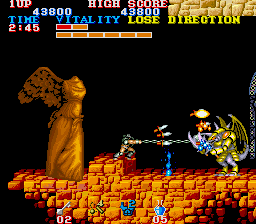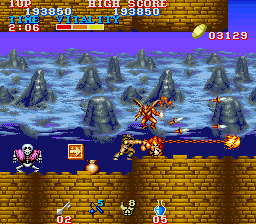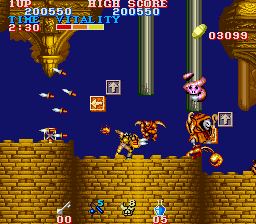- Black Tiger
- SonSon II
Capcom’s Black Tiger is one of the many dark fantasy barbarian-themed arcade games of the mid/late 80s, undoubtedly inspired by the Conan the Barbarian movie and the many fantasy movies that were in vogue at the time. You control the eponymous Black Tiger, a muscular warrior of tremendous strength, as he treks through eight levels and defeats the three dragons that have been pestering the kingdom. Oddly, the game is called Black Dragon in Japan, shifting the title to the main enemy rather than hero, though it’s unclear why – maybe “tiger” just sounded more distinct? It did have the benefit of having a similar title to Capcom’s Tiger Road, another action game released the same year, though that has more of a martial arts theme.
Black Tiger takes a number of elements from the earlier Ghosts ‘n Goblins series. The hero starts off with armor, which is knocked off after taking enough damage, leaving him to just his iron loincloth. Run out of vitality in this state (which will happen very quickly, since you only start with one block) and you’ll crumble into bones and dust. Prominent enemies include skeletons, which routinely pop out of the ground to harass you, as well as the the famous Red Arremer/Firebrand enemy, though he wields a spear and doesn’t quite have the same annoying behavior. Still, the Black Tiger is more well equipped than Arthur ever was, even though his arsenal isn’t quite as large. He wields throwing daggers, tossed three at a time in a low arc, as well as a long flail, both of which are used simultaneously whenever hitting the attack button.
In the late 80s, role-playing games were all the rage in Japan thanks to the popularity of Dragon Quest, and so some arcade games tried to blend these elements into them. In Black Tiger‘s case, this means collecting money from fallen enemies, as well as treasure chests and breakable jars. This marks the first appearance of the “zenny” currency, reused in many later Capcom games, including Forgotten Worlds, Breath of Fire, and Mega Man Legends. The word itself is derived from “zeni“, an old Japanese term for money. Among the other items you can find are POW icons, imported from various Capcom shooters, which will destroy everything on the screen.
Throughout each land are statues, which are really men that have been encased in stone. Some are generous enough to grant you free items, others give mostly useless tips, and a few give even more useless “thank you”s. Every once in awhile, you’ll find one that will set up shop, allowing you to purchase a variety of items. One of the most important among these are improved weapons, which enhance the power of your flail. Once obtained, it will never go away, even if you continue, so it’s yours as long as you keep pumping quarters into it. There’s no benefit to upgrading each and every weapon, so prudent gamers may just opt to keep the weakest one while saving up for the strong (flame) whip, and then never have to worry about upgrading them again. At this point, you can just spend all of your money on better defensive equipment. The enhanced armors are not permanent, though, and degrade when taking hits. So these are more useful in cases where you need to be able to weather a lot of damage, particularly for boss fights. The shopkeeper’s goods are rounded out by keys, used to open treasure chests, and potions, which are automatically used if you’re inflicted with a status element by an enemy (“poison” will stop you from throwing daggers, while “lose direction” will reverse your controls).
The score even acts as an experience system, of sorts. At certain intervals, you’ll earn an extra vitality block, so you can survive for a tiny bit longer once your armor is knocked off. You’ll keep the extra lifebar even after continuing, but your score does reset, so you’ll need to last as long as possible if you want to build this up.
There are direct paths through the levels (indicated by arrow signs), and they sprawl in all directions, with columns and vines you can climb up to reach greater heights. There are many branching routes and sidepaths though, including special rooms called “dungeons”. These have plenty of extra power-ups, providing you can make it out alive, because if you die, you’re kicked out and cannot re-enter. Hidden items can also be found by destroying certain walls. Most items will be familiar to Capcom fans, including the bamboo shoots seen in SonSon, the screen-clearing POW icons, and the windmill Yashichi icon.
The RPG elements are pretty interesting, at least in how they give some extra utility and customization to the knick-knacks you pick up, but certain elements aren’t that well thought out. There’s a time limit to prevent exploring too much grinding or wandering around, which is fine, considering it’s still an arcade game. But shopkeepers disappear once you’ve met them, so you’re pretty much at the mercy of when the game wants to dispense them to you. If you’re just short of getting an item you want, you can’t just leave, get enough money, and return – you’re just out of luck. If you die in front of a boss and want to buy extra armor? Unless you can backtrack to find a guy you haven’t rescued, AND gather enough money from any enemies that might still be remaining, you’ll just have to make do with your default equipment. (Though to be fair, that Black Tiger even offers this option makes it more forgiving than many arcade games, where they’ll just force you to deal with it if you die and lose your power-ups.) The exception to this is the last boss, where the frozen shopkeeper helpfully respawns after visiting him.
As with many Capcom games of the era, Black Tiger is quite difficult. Enemies are relentless, as you deal with randomly spawning goons as well as orcs, mummies, slimes, demons, and other creatures. The levels are also filled with traps, ranging from booby-trapped chests and jars, to man-eating plants hidden beneath the ground, to boulders that fall out of almost nowhere. Those last are particularly tricky because they’ll kill you outright, even if you’ve got the strongest armor. If you’re careful or have memorized the stages, you can avoid most of these, but it still adds to the unrelenting challenge. The Japanese version is actually more difficult, seeing how there are even more boulder drops, plus some of the boss battles are harder, as the American version changed the collision so you can dodge certain attacks. Plus, almost everything in the shops is more expensive in the Japanese version.
There’s also some visibility issue with the UI, since the vitality meter at the top of the screen is only the health of your character without their armor. Your actual armor durability is just a tiny number at the bottom of the screen, so basically you have two separate life meters at completely different locations, rendered completely differently. This sure captures the “needlessly cluttered” aspect of stereotypical RPGs.
The main reason why this game isn’t quite as overwhelmingly difficult as Ghosts ‘n Goblins is that the checkpoints are actually extremely common. And while you can’t take many hits, usually you can make it from point-to-point without having to regain too much territory. The bosses will put up a challenge, but they aren’t too difficult once you know their patterns and weaknesses. So it might take a bunch of credits, but with enough tenacity, you can make your way to the end.
The bosses are pretty disappointing, though. There are only a handful of these, repeated throughout the game. The last boss fight against the Black Dragon is particularly anticlimactic, considering you’ve already previously fought two incarnations that are almost identical, the only difference is that the final one can take more hits than all of the others.
The visuals aren’t exactly stunning, but they’re decent. Considering they’re going for a Western fantasy feel, it doesn’t quite have the morbid cartoonishness of the Ghosts ‘n Goblins series, and the sprites are pretty small compared to something like Rastan. Still, they’re detailed and well animated, and the atmosphere has an appropriately dark vibe. Most of the game takes place in underground stages, but the few that take place against the background of blue skies are the most visually striking. The main theme music is catchy – again, not quite Ghosts ‘n Goblins level, but hummable. Then again, that’s maybe because most of the soundtrack uses a variation on the same piece of music, which is how it can worm its way into your head.
Black Tiger suffers in the same way that most of these arcade-RPGs do, mostly in that the balance never seems quite right. Until you get equipped with decent weapons, if feels like enemies take too much damage, while your buff muscled warrior just folds like paper. It’s even worse if you’re playing at anything but the lowest difficulty level. Still, for 1987, it’s a pretty ambitious game, due to its relatively wide-open levels and shop system, along with the extra layer of strategy that comes with hunting for gold and economizing your purchases. Plus the heroes’ awesome dual weapon set is immediately striking, enough to make it stand out from other similar games. Sure, Rygar had a deadly yo-yo, but could he toss a spread of knives at the same time?
Black Tiger was seemingly in the works for an NES port, but the only proof of its existence lies in a couple of blurry magazine shots. Given how little of it was publicly seen or previewed, it probably didn’t get far along in development. It’s a shame, since many NES Capcom ports provided substantial enhancements over their arcade originals, and this is exactly the type of game that could’ve benefited from that extra polish, even with lesser graphics.
Though Black Tiger was never ported to contemporary consoles, it did show up on the usual round of European home computers. The Atari ST and Amiga versions are basically identical. On the surface, they look really good – the visuals are imported directly from the arcade version, and while it has lower color depth, it’s still comparable in quality. But every pretense of a decent port goes right out the window the minute you see it in motion, because it’s incredibly choppy, and quite a bit slower than the original. There’s no music either, just sound effects. It seems the Amiga version is a direct conversion of the Atari ST program, without taking advantage of the extra hardware, which accounts for its shoddiness.
The Commodore 64 version has an ugly color palette, and there simply aren’t any backgrounds, so it looks really dark. The action is a little too fast, too, so it doesn’t feel quite right. Some of the levels have been cut and what are present are scaled back and changed from the arcade game (the spinning skulls appear right in the first stage, for example). The main theme has been replaced some generic, repetitive piece of music, while the real arcade theme is strangely only used in the dungeon segments. It’s not a great port, but it’s better than the others.
The Amstrad CPC and ZX Spectrum ports are almost identical. They’re more zoomed in than the others, the action is a little slow and choppy, and the level designs aren’t quite faithful either. The CPC version does have some okay music, at least.
Black Tiger never received a direct contemporary console ports, but it was drastically reworked into SonSon II for the PC Engine, which keeps the same basic gameplay put sticks into a Far East-inspired world based on the Monkey King legend, starring Son Son from the early 80s arcade Capcom game of the same name. The arcade/SNES game Magic Sword is sort of a spiritual successor to this game, in that it keeps the fantasy and RPG elements, but ditches the exploration and tones down the platformer to turn it into a more straightforward brawler. That in turn paved the way for Capcom’s Dungeons and Dragons beat-em-up series published in the early 90s.
An arcade emulation is presented on Capcom Classics Collection Vol. 2 (PS2/XB), Capcom Classics Collection Remixed (PSP) and as one of the pack-in games with Capcom Arcade Cabinet (PS3/X360). The latter offers a “casual” mode which will start you out with max vitality among other tweaks. It was also available for download on the Wii Virtual Console.
Black Tiger is also one of the many video game referenced in Ernest Cline’s Ready Player One novel, being one of the games that the hero has to play in one of the challenges. It was cited as being of the author’s favorite childhood arcade games. It was not featured in the movie, however, in spite of Capcom properties appearing elsewhere. This is probably because the game was not hugely popular otherwise (presumably due to the lack of an NES port), plus outwardly, it’s really just a generic barbarian game.
Links:
